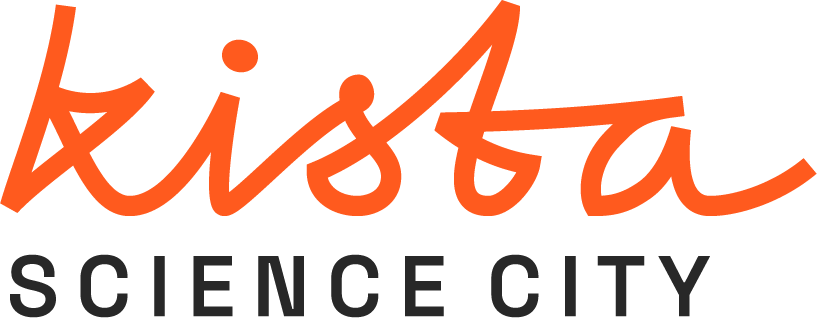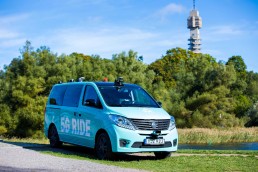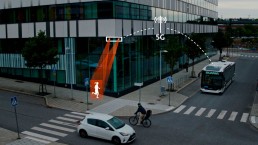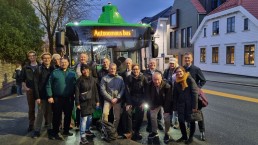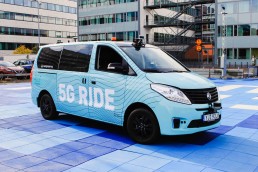Driving the future: Insights from Future 5G Ride
How can autonomous vehicles be safely integrated into public transport systems? And what does it take to manage them without a driver behind the wheel?
Over the past 3.5 years, the Future 5G Ride project has explored these questions—serving as a testbed for connected, driverless mobility. It combined 5G, AI, and smart infrastructure to investigate how autonomous vehicles can operate safely as part of a broader transport ecosystem. This included coordination between vehicles, infrastructure, and the digital systems used for supervision and traffic management.
Led by Kista Science City and involving a broad mix of partners from industry, academia, and public transport, Future 5G Ride focused on practical integration. Vehicles, sensors, and operations were connected and tested together to explore how autonomy could work at scale.
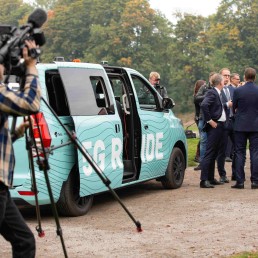
What we learned
Autonomy begins with the system
A key lesson from Future 5G Ride is that autonomous public transport can’t rely on vehicle intelligence alone. To be safe, scalable, and effective, it needs to be part of a larger system—connected not just to other vehicles, but to roadside infrastructure and human operators.
The testbed explored what that system looks like in practice: vehicles, infrastructure sensors, and control centers working as one. This fleet-based model makes it possible to coordinate operations centrally, respond in real time, and scale autonomy for everyday use in public transport.
Safety comes from shared awareness
Future 5G Ride showed how combining infrastructure sensors with AI-supported monitoring can address two distinct safety challenges in driverless public transport: situational awareness around the vehicle, and passenger safety inside it.
Roadside sensors helped detect pedestrians and traffic changes, extending the vehicle’s awareness beyond what onboard systems could see. This improved its ability to respond to external conditions in real time. Inside the vehicle, AI-assisted monitoring focused on passenger well-being—detecting incidents or unusual behavior that could require remote intervention.
Together, these capabilities showed how operations can be safely supervised from a distance, reducing the need for onboard staff while improving working conditions overall.
“To be safe, efficient and comfortable in intensive urban traffic, autonomous vehicles need to be aware of all surrounding road users,” says Dr. Yuri Tarakanov, Research Manager at Viscando. “Future 5G Ride gave us the chance to demonstrate how infrastructure sensors can extend the situational awareness of autonomous buses—especially in dense urban settings where vulnerable road users and cars can be hidden from the autonomous vehicle by for example building walls or vegetation.”
Reliable connectivity is the key to future deployment
The testbed made clear that real-time autonomy only works when networks are ready for it. Remote supervision, live data-sharing, and system-wide coordination all depend on robust, low-latency communication, especially in complex urban settings. By testing both public and private 5G networks, the project highlighted what reliable connectivity actually looks like in practice—and why continued network development is critical to scaling autonomous transport beyond isolated pilots.
Collaboration that drives innovation
Future 5G Ride brought together partners from across sectors—each contributing the capabilities needed to develop, test, and validate autonomous transport in operational settings:
- Tech leaders (Ericsson, Telia, Intel) provided advanced 5G and AI capabilities.
- Innovative scale-ups (Applied Autonomy, Viscando) introduced new solutions and fresh perspectives.
- Public transport authorities (Vy, Region Stockholm) ensured the project’s relevance and practicality in real-world conditions.
- Academic research institutions (KTH, ITRL) provided insights into societal impact, human interaction, and scalability.
“Future 5G Ride gave us valuable confirmation of how to work across the value chain. The experience has helped us scale cybersecure, operational solutions across Sweden and internationally—and we’re happy to share what we’ve learned to support safer, more sustainable mobility.” — Olav Madland, CEO of Applied Autonomy.
The road to deployment
Future 5G Ride is now complete—but its outcomes point forward.
By deploying autonomous public transport in active traffic scenarios, the testbed helped show what it takes to move from isolated pilots to scalable, system-level solutions. It validated core technologies and clarified what’s still needed to make autonomous public transport a part of everyday life.
To move from testing to widespread use, several things still need to be in place:
- Scalable integration of autonomous systems across cities and public transport networks
- Robust 5G infrastructure across more geographic areas and real-world use cases.
- Clear policy frameworks to support safe, large-scale deployment
- Public trust to enable adoption and long-term success.

“HRH Prince Daniel at the launch of Future 5G Ride, 24 September 2020. Autonomous transport has come a long way since.”
“Future 5G Ride has shown what it really takes to make autonomous public transport work — not just removing the driver, but rethinking the entire system around them. By combining 5G connectivity, AI monitoring, and remote supervision with a strong collaborative model, we’ve shown how we can build systems that can truly move public transport forward.” — Lucas Uhlén, Project Manager at Kista Science City.
As coordinator of Future 5G Ride, Kista Science City helped bring together partners from across sectors—creating the conditions for practical testing, shared learning, and long-term collaboration. We’ll continue to support initiatives like this to strengthen Sweden’s role in mobility innovation.
Want to get involved?
Reach out to Lucas Uhlén at lucas.uhlen@kista.com
5G Ride: paving the way for a better public transport
Four years ago, representatives from the telecoms industry, academia and the public sector teamed up to test a 5G-connected autonomous vehicle for public transport. Today, the project has expanded with new partners and resulted in technical solutions that make autonomous vehicles better in terms of safety and security while efficiently integrated in the transport system.
Back in 2020, Kista Science City, Ericsson, Telia, Keolis and Intel, with financing from Vinnova and Drive Sweden, launched the 5G-connected and autonomous electric minibus 5G Ride on the island of Royal Djurgården in the Swedish capital, Stockholm. Prince Daniel of the Swedish Royal Family was among the dignitaries that attended the official inauguration ceremony. Since then, Scania, KTH, Region Stockholm, T-Engineering, Viscando, Vy and Applied Autonomy have joined the project, putting focus into technical solutions that make autonomous vehicles safe in traffic, secure for passengers and efficiently integrated in the overall transport system.
Subsequent achievements include further developing the Traffic Tower concept from Applied Autonomy using a 5G connection to monitor and manage fleets of self-driving vehicles on public roads, as well as deploying sensors in infrastructure that enhance the traffic perception of self-driving vehicles by sharing real-time traffic data via a low latency reliable 5G network.
Throughout the project, the goal has been to ensure safety and stability for solutions to be implemented in regular traffic, and to make 5G-enabled electric driverless public transport services a reality. Ericsson has contributed with a private 5G network to evaluate how new features in 5G can support the use cases in question. Telia provided connectivity through its public 5G network and a private 5G network at Scania’s test track in Södertälje in collaboration with Ericsson. Intel delivered analytics and processing for onboard AI, while both Scania and Applied Autonomy delivered vehicle and self-driving technology. Viscando provided smart 3D&AI based infrastructure sensors, and KTH conducted research on both 5G network capacity and advanced sensor fusion and driving logics. In addition, Vy Buss has investigated how customers experience safety on board when the bus is driven without a safety driver. Through focus groups, Vy has also investigated how communication between the control tower and the bus worked in an emergency.
On September 26, the Future 5G Ride project will showcase key enablers for autonomous transport in Kista Innovation Park, focusing on safe and inclusive journeys. Visitors can experience a ride in the driverless vehicle and learn about crucial aspects such as robustness, passenger interaction and the ability of 5G to serve various strict application requirements on demand – known as differentiated connectivity.
Lucas Uhlén, Project Manager at Kista Science City, says: “The 5G Ride project unites a diverse consortium of partners, working together to challenge and innovate within autonomous driving and sustainable public transport. Kista Science City continues to play a supportive role in expanding these partnerships, bringing in new collaborators, and ensuring that the technical development of each partner is aligned with the overall goals of the project. By bringing together different perspectives and expertise, we are accelerating innovation and creating scalable solutions for the future of public transport.”
Magnus Leonhardt, Head of Strategy & Innovation, Telia B2B, says: “The 5G Ride project has given us unique insights around the demands on connectivity, and 5G specifically, to enable self-driving vehicles to be deployed safely in public transport. We have also had the opportunity to use our joint capabilities in our 5G-innovation program NorthStar, that we run with Ericsson and that Scania is also part of, to trial key scenarios in the 5G Ride-project. We look forward to continuing this work with customers and partners in public transport and the automotive industry, to allow for the transition to safer, more efficient, and sustainable solutions for public transport.”
Håkan Olofsson, Head of Systems Concepts & Algorithms, Ericsson, says: “5G Ride is a good example of a use case with strict 5G requirements. The project shows that when these strict 5G requirements arise during a journey, 5G capabilities are provided instantly via network APIs, that allow application developers to easily access 5G capabilities such as differentiated connectivity. Ericsson’s network support for differentiated connectivity ensures a reliable network performance, even at times of peak network load.”
Olav Madland, CEO of Applied Autonomy AB, is enthusiastic about scaling these autonomous transport services in Sweden and Europe. He says: “Based on the outcomes of this project, mobility operators can offer passengers a seamless and comfortable experience in driverless vehicles. Our Control Tower, xFlow, leverages integrations with Ericsson and Intel to provide a comprehensive solution for operators.”
Applied Autonomy establishes Swedish hub
Applied Autonomy establishes Swedish hub
Applied Autonomy, known for innovative work in autonomous transportation, has chosen Kista as a strategic hub for their Swedish operations. This decision marks an important step in the Norwegian company’s expansion and commitment to grow within the Swedish market.
Swedish base
Choosing Kista as a Swedish hub reflects Applied Autonomy’s commitment to being closer to key partners and to becoming part of the dynamic tech landscape in the area. CEO Olov Medland shares his perspective on this strategic decision:
– Kista’s unique combination of technological expertise and collaborative culture made it an ideal choice for us. We are excited about being part of this tech community, contributing to and benefiting from the synergies it offers.
Applied Autonomy is positioned to play a significant role in the evolving landscape of urban transport in Stockholm and Sweden. The company is enthusiastic about sharing its insights and experiences in autonomous transport and collaborating with other companies and innovators in this field. “The possibilities are endless, and we’re eager to explore them,” says Medland.
5G Ride
Applied Autonomy has recently joined the 5G Ride project. Central to their contribution is the xFlow® platform, an innovative solution that ensures a seamless link between vehicles, operators, and end-users, thereby enabling safe and efficient transport. Medland emphasizes the importance of this project:
– Joining 5G Ride was a natural decision for us. The project aligns perfectly with our capabilities, including xFlow®, and our commitment to shaping the future of autonomous transportation. Our participation in this innovative project is an excellent opportunity to demonstrate how our technology can be integrated into existing urban transport systems, enhancing safety, efficiency, and overall user experience.
Cross-border dialogue on autonomous public transport
In November 2023, the 5G Ride project partners from Ericsson, RISE, & Kista Science City, in collaboration with Drive Sweden Policy Lab, Trafikverket, and Transportstyrelsen visited Stavanger, Norway, to observe a full-scale autonomous bus in a real urban setting. This visit allowed the teams to witness the operation of a self-driving, full-scale bus navigating complex urban conditions, including traffic lights, roundabouts, lane changes, and a tunnel, at speeds of up to 40 km/h.
Observations from Stavanger
The primary objective of the Norway trip was to discuss and understand the challenges and opportunities of advanced pilot projects in autonomous public transport. The discussions highlighted the importance of close collaboration between different stakeholders – including tech developers, public transport authorities, and regulatory entities – to drive progress in this complex field. This approach is crucial for combining expertise, sharing insights, and aligning efforts towards common goals in autonomous transportation. Additionally, local Norwegian partners emphasized the value of continual development, focusing on real-world testing of these systems to enhance safety and efficiency in urban mobility.
A key topic during the Stavanger visit was the comparison of the regulatory environments for autonomous vehicle testing in Sweden and Norway. Each country’s approach to regulations and funding for research projects has significant affect for the development of autonomous transport solutions. This highlighted the importance of adaptable regulatory frameworks in supporting advancement and innovation within this field.
Applied Autonomy
The visit to Norway was hosted by Applied Autonomy, a new partner in the 5G Ride project. As a company specializing in software solutions for autonomous transportation, Applied Autonomy brings crucial expertise to the project. Their involvement is expected to enhance the project’s capabilities, particularly in terms of scalable and adaptable autonomous solutions. This partnership marks a big step in the collaborative effort to develop and implement advanced autonomous transport systems.
In addition to Applied Autonomy, the Norway visit saw participation from several organizations, including Adastec, Vy, and Kolumbus, along with representation from Statens vegvesen. Each of these organizations contributed to the success of this trip, bringing unique perspectives and expertise to the discussions and demonstrations.
Future Directions
Looking ahead, the 5G Ride project plans for new demo days and test with autonomous vehicles in Stockholm in 2024. As the project enters its next phase, the project remains committed to leveraging international learnings and local expertise to revolutionize urban mobility. The combined efforts are key in our journey towards a more connected and sustainable future in public transportation.
Seeing through obstacles and around corners, the 5G Ride project rolls on
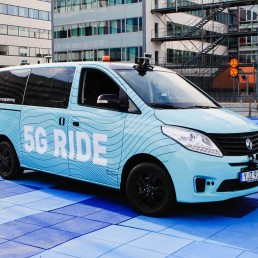
Drones
Seeing through obstacles and around corners, the 5G Ride project rolls on
The 2022 5G RIDE Demo Day on October 13 gathered more than 50 special invited guests and project partners who got a sneak preview of the latest technology updates.
This year’s demonstration focused on how new technology can be used to increase safety and security around autonomous vehicles in commuting traffic, hence offering a safer experience for travellers and other road users. The visitors got to experience how smart sensors on vehicles and in the surrounding infrastructure makes it possible for the vehicle to see through obstacles and around corners.
The sensors are an important addition to the project, as they measure positions and paths/route for all road users and sends this data in real time to Ericsson Innovation cloud, via 5G, where the data is processed, combined with other sources, and shared with the connected vehicle. The vehicle is acting upon the combined picture, from sensors, traffic tower, own cameras and the surrounding. In real time. During the demonstration we could see what happens if a person crosses the street if there is an obstacle on the path and how buildings and people are plotted on the onboard screens.
The technology enabling this is the 5G network and the traffic tower, as they fetch and share real-time data from the vehicle.
The ambition of the 5G RIDE project is to create conditions for an efficient and sustainable public transport where operators in traffic towers can support fleets of autonomous, electric vehicles to improve traffic planning, safety and reduce energy consumption. By taking a unified approach and combining technologies, the next step in the development of driverless automated vehicles is taken.
This project takes place in a collaboration between some of Sweden’s leading companies in mobility and technology. Kista Science City AB, Keolis, Ericsson, Telia, T-engineering, Viscando, Scania, Region Stockholm, intel and KTH. Working together to create a more environmentally smart and cost-efficient transport system.
For more information about the project
project manager Eleonor Sjödin Turah
eleonor.sjodinturah@kista.com
Sign up to get the latest news, updates and insights from Kista Science City
5G Ride
5G Ride
Autonomous vehicles
The project
5G Ride is a concept for self-driving, 5G-connected electric vehicles used in public transport.
The purpose of the project is to develop and test connected autonomous vehicles to get closer to an implementation of autonomous vehicles on public roads.
The 5G network’s unique technical features, including enhanced security, extremely high data speeds combined with low latency, means that the connected buses can respond in real time to commands from the centralized control tower.
In 2021, additional funding was added to the project and the focus for the continuation of the project is the further development of the Connected Control Tower. One part of this is how to use more data, for example about the route, the vehicle or the connection strength, to make it possible to prevent any problems, plan routes and schedules better and act more swiftly should problems arise.
Project period
2020-2025
Partners
Keolis
Ericsson
Telia
Intel
Scania
Viscando
T-Engineering
Royal Institute of Technology
City of Stockholm
Region Stockholm
AppliedAutonomy
VY
Contact
Lucas Uhlén
lucas.uhlen@kista.com
Downloads

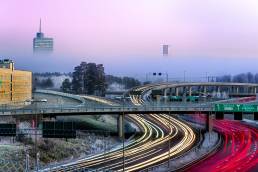
The pilot
The pilot in 2020 was the result of a unique collaboration between some of Sweden’s most prominent and well-known organizations within the fields of mobility and technology.
The knowledge hub and testbed Urban ICT Arena managed the initiative, with Keolis as bus operator. Ericsson provided the technical solution for the connected control tower, a solution that will be further developed during 2021.
Telia provideded the 5G-connectivity in collaboration with Ericsson and deployed 5G at Djurgården specifically for this project. Intel delivered analytics capabilities and the technology for the processing across the network including the IT-system in the vehicles and the control tower, as well as the mobile network. T-Engineering, a Swedish technology firm, delivered vehicle and self-driving technology.
HRH Prince Daniel was among the dignitaries to attend the official inauguration ceremony outside Tekniska museet.
